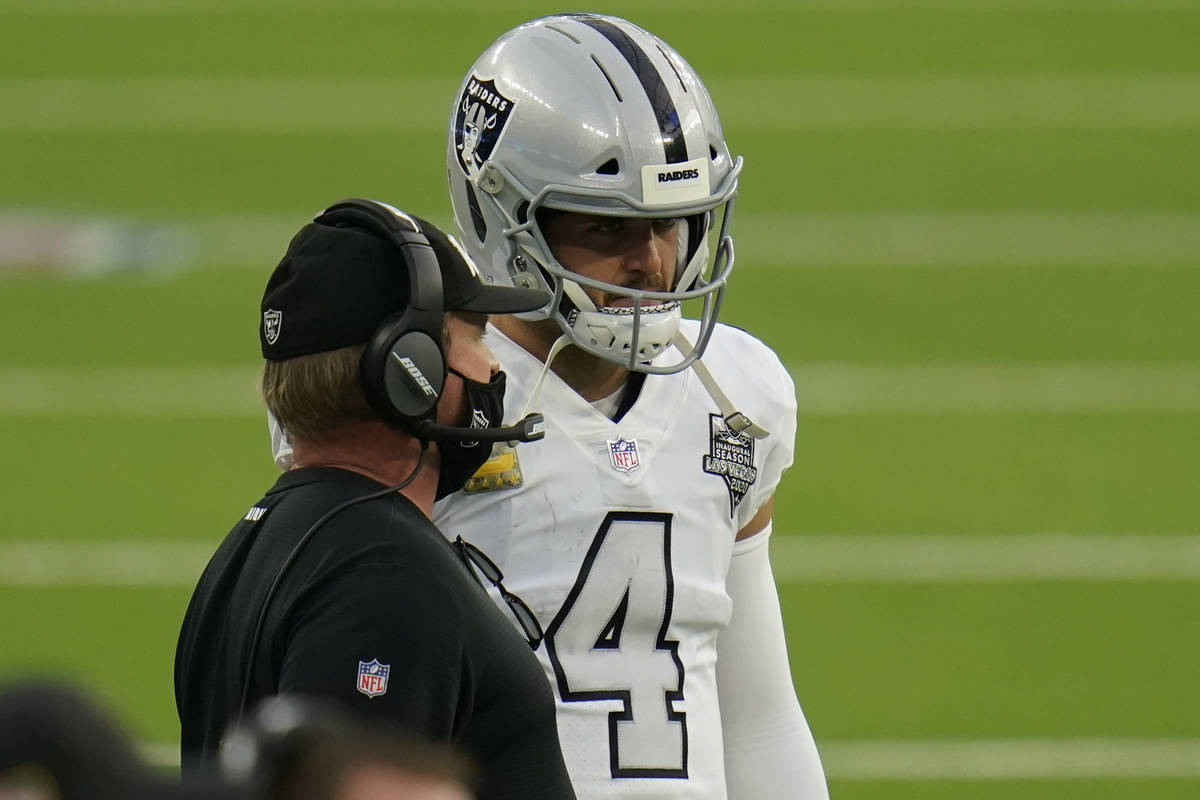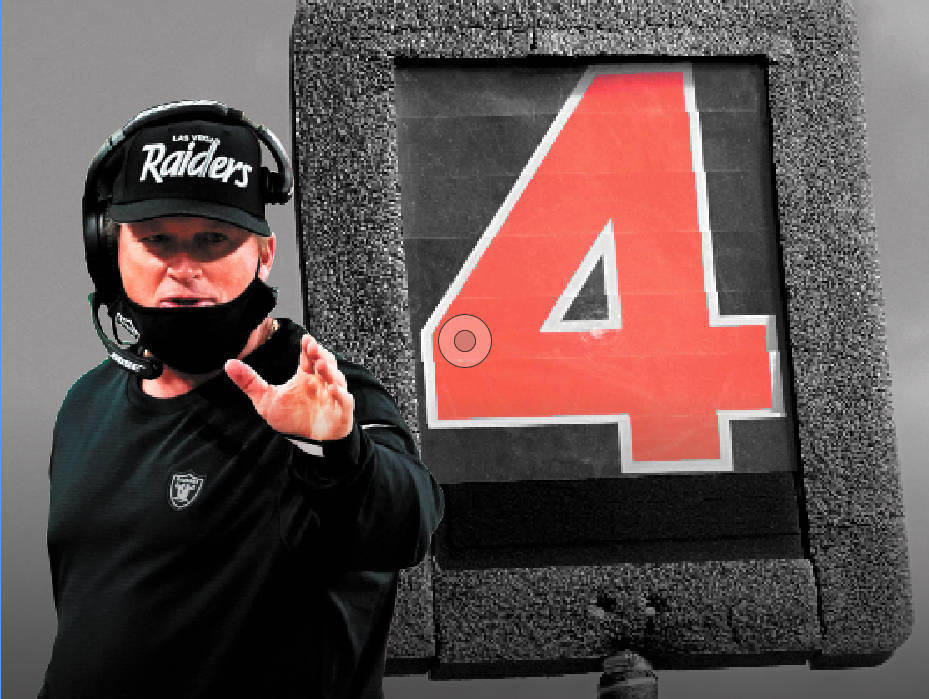Raiders, NFL playing more and more by the numbers
The wealth of analytical data that exists in the NFL wasn’t there when Tom Flores coached the Raiders. The percentages weren’t as prevalent, the conversion rates so readily available.
So when Flores was faced with a difficult decision like, say, going for it on fourth down, or punting or kicking a field goal, he relied on something less scientific and more intangible.
“A lot of that had to do with a gut feeling,” said Flores, 83, a two-time Super Bowl champion and finalist for the Pro Football Hall of Fame. “A lot of that had to do with who you were playing. A lot of that had to do with who you had trying to make the fourth down.”
Today’s coaches have a little more to go on than a gut feeling.
The emergence of analytics is changing the way the sport is coached, with advanced data influencing game plans and crucial in-game decisions. The new wave of metrics also provides more complete, reliable data that teams can use to evaluate players as they construct their rosters.
Pro Football Focus, for instance, supplies analytical data to all 32 NFL teams and dozens of FBS college programs. Teams have their own analytics staffs that aggregate and process pertinent data. Other outlets like Football Outsiders and Sharp Football Stats compile and present data in a manner that’s digestible for media and fans alike.
Math and football are forever intertwined.
Raiders coach Jon Gruden, 57, has embraced analytics, noting that the organization takes “a lot of pride in being analytical” and uses “a lot of statistical data, tendencies.”
“As much as Jon Gruden gets labeled as kind of an old school coach, and people like to paint him that way, he understands where all this data comes from and how much of a benefit it could be,” said Pro Football Focus analyst Sam Monson. “They’re well aware of what that kind of data can do … how much better it can make them if they truly embrace it.”
Changing the game
The applied use of analytics is most reflected through play calling — particularly on fourth downs, Monson said.
Teams these days are apt to run plays from scrimmage more frequently on that down instead of automatically punting or kicking field goals the way they would when Flores coached. In 2017, NFL teams averaged 15.2 fourth-down attempts, a figure that spiked to 16.8 in 2018 and 18.6 in 2019.
They’re on pace this year to average 20.6.
“NFL teams are starting to understand that there isn’t really a downside to playing the mathematics on some of these decisions,” said Monson, who has worked for Pro Football Focus since 2010, well before analytics penetrated the mainstream. “It’s not necessarily the difference between winning and losing every single week, but it’s just buying yourself a little bit of an edge here and there.”
The Philadelphia Eagles are a sterling example of the analytical evolution, trusting the math all the way to a 41-33 victory over the New England Patriots in Super Bowl LII. They led the league in fourth-down conversions during the 2017 season, averaging 1.1 per game to foreshadow the line of progressive thinking that would propel them past the Patriots.
They converted a pair of fourth downs against New England in the Super Bowl, including the infamous “Philly Special” on fourth and goal from the 1 that resulted in a touchdown reception by quarterback Nick Foles.
Pro Football Focus owner and former NFL wide receiver Cris Collinsworth said that Philadelphia was the first franchise “to adapt the new age of math,” though plenty of others have followed suit, resulting in a more aggressive, progressive style of play.
“A lot of people get really mad at that, because if the coach decides to go for it and they don’t make it, they think he’s an idiot because it didn’t work,” said Collinsworth, who also works as a color commentator for NBC’s “Sunday Night Football” and called the Raiders’ 35-31 loss Sunday to the Kansas City Chiefs.
“In reality, most of those calls are like 51-49 (percent in favor of going) for it, 52-48 go for it,” he added. If you play out that tiny percentage over the course of a season, Collinsworth said it will win you some games.
How the Raiders compare
Collinsworth tends to hear most from his Pro Football Focus staff about the teams that are more extreme. Extremely analytical or extremely antiquated.
The Raiders, he said, fall somewhere in the middle.
They do average 0.8 fourth-down conversions, ranking 12th among the NFL’s 32 teams. Their conversion rate of 80 percent is second. But they’ve only tried 10 times for a first down on fourth down, tied for 23rd.
Gruden and the Raiders were faced with a fourth and goal from the 1 in their loss to the Chiefs and deployed kicker Daniel Carlson to try for a field goal. A 15-yard penalty ultimately rendered the decision moot.
A more analytically inclined team likely would try for a touchdown in that situation instead of settling for three points against an explosive team like the Chiefs.
“We take analytics as far as we can. But at the end of the day, there’s a lot of human error that I continually make,” Gruden said, only partly in jest. “We try to use as much help as we can get. We take pride in studying all the data.”
Derek Carr is in the midst of a career year for the Raiders. He is grading out as Pro Football Focus’ seventh-best passer among the 38 qualified quarterbacks. He said there are certain tendencies revealed by analytics that intrigue him, but he noted that he doesn’t delve too much into advanced data, preferring an old school approach instead.
“I watch the film, and I see what I see. I learned it that way, and I trust my process that way,” Carr said. “There’s also some stuff out there that’s a little bit of a reach when it comes to real football stuff. But there are definitely a few things that help.”
Whatever works.
The Raiders this season are in the top third of the league in scoring (28.6) and lead the league in third-down conversion percentage (51.61), thereby limiting some of those difficult fourth-down decisions.
Oh, and they’re 6-4, and Football Outsiders gives the Raiders a 65.9 percent chance at qualifying for the postseason based on 30,000 simulations of the remainder of their schedule.
How’s that for data?
Contact reporter Sam Gordon at sgordon@reviewjournal.com. Follow @BySamGordon on Twitter.
























